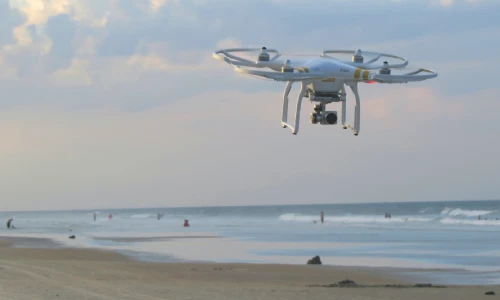
The dangers of flying a drone at the sea
 Flying a drone near the sea presents several piloting challenges and avoidable hazards that drone pilots must consider and overcome to ensure a safe and successful flight.
Flying a drone near the sea presents several piloting challenges and avoidable hazards that drone pilots must consider and overcome to ensure a safe and successful flight.
Among the most common are:
- Wind: Strong winds near the sea can make challenges for the drone to maintain its stability and altitude, which resulting in dangerous flight. Also, they can seriously interfere with flight and drag the aircraft into the sea.
- Water Interference: Water can interfere with the drone's GPS signal, causing navigation errors and loss of control. This can happen at great distances and also during hot summer days when water evaporation is greater.
- Sea spray: Sea spray from large waves can damage the drone's camera lens, making it difficult to capture clear footage.
- Corrosion in Salt Water: Salt water can cause corrosion of the drone's electrical components of the drone, which can lead to system malfunctions and crashes.
- Risk of crashing into the water: Drones can crash into the water due to technical malfunctions or incorrect piloting, making it difficult to get back the drone and retrieve valuable data or footage. Losing a drone can cost us serious financial loss.
- Limited battery life: The combination of strong winds and the drone's proximity to water can drain battery life faster, which leads to shorter flight times.
- Lighting changes: Тhe light near the sea can change quickly, making it difficult to adjust the drone's sensors and maintain a stable flight. Before a flight, it is good to consider the need to put filters on the camera of the drone.
- Obstacles: Pilots should also be aware of objects such as boats, ships, and buoys that could interfere with the drone's flight path and cause a collision. Also, let's not forget about the multitude of beachgoers, swimmers and tourists in all the beautiful destinations.
- Distraction: Marine wildlife such as seagulls or dolphins can distract the pilot and cause him to lose control of the drone. People who are curious about flights can also be a distraction, such as a small children.
- Privacy concerns: Flying a drone near the sea can also raise privacy concerns for people on board or on coast. Drone pilots should be aware of and comply with local regulations regarding the use of drones in these areas.
- Regulatory restrictions: Flying a drone near the sea may be restricted by local regulations or restricted airspace, such as near naval bases or oil platforms. Drone pilots should research and understand these limitations before flying.
To overcome these challenges, drone pilots must carefully plan their flight routes and take the necessary safety measures to protect their drones from damage. They must also be aware of their surroundings at all times and be prepared to change their flight plans if necessary to avoid obstacles or endanger nearby people.
29 January, 2023 EN
EN  BG
BG